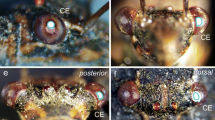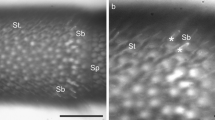Summary
The characterization, distribution, arrangement and branching pattern of the retinal receptor-cell endings in the first and second synaptic region, the lamina and medulla, were studied in various regions of the compound eye of the drone bee. Light- and electron-microscopical Golgi techniques were applied in these investigations.
-
1)
The nine receptor cells in each ommatidium of the drone bee — like in the worker bee (Ribi 1974, 1975, 1979) — end as six short visual fibres (two svf1, two svf2, two svf3) in the lamina, and as three long visual fibres (lvf 1, 2, 3) in the medulla.
-
2)
In the frontal dorsal region of the eye the four receptor cells known to terminate either as svf2 and svf3 axons, respectively, display — in this particular region of the eye — one and the same distinct type of short visual fibre (svf4).
-
3)
This sex-specific short visual fibre shows a highly branched axonal ending, which reaches the proximal part of stratum A. The numerous laterally arranged sidebranches interweave with the nerve fibres of the cartridge and are presynaptically connected with mainly L1 and L2 interneurones.
-
4)
The sex-specific receptor type is found in the field of view where the diameter of ommatidial lenses shows a maximum and which is used while chasing the queen.
Similar content being viewed by others
References
Autrum H, Zwehl V von (1962) Zur spektralen Empfindlichkeit einzelner Sehzellen der Drohne (Apis mellifera). Z vergl Physiol 46:8–12
Autrum H, Zwehl V von (1964) Die spektrale Empfindlichkeit einzelner Sehzellen des Bienenauges. Z vergl Physiol 48:357–384
Beersma DGM, Stavenga DG, Kuiper JW (1977) Retinal lattice, visual field and binocularities in flies. Dependence on species and sex. J Comp Physiol 119:207–220
Collett TS, Land MF (1975) Visual control of flight behaviour in the hoverfly, Syritta pipiens. J Comp Physiol 99:1–66
Dietrich W (1909) Die Facettenaugen der Dipteren. Z wiss Zool 92:465–539
Franceschini N (1975) Sampling of the visual environment by the compound eye of the fly. In: Snyder AW, Menzel R (eds) Fundamentals and applications. Springer, Berlin Heidelberg New York, pp 98–125
Franceschini N, Hardie R, Ribi W, Kirschfeld K (1981) Sexual dimorphism in a photoreceptor. Nature 291:241–244
Hardie RC (1983) Projections and connectivity of sex-specific photoreceptors in the compound eye of the male housefly (Musca domestica). Cell Tissue Res 233:1–21
Hardie RC, Franceschini N, Ribi W, Kirschfeld K (1981) Distribution and properties of sex-specific photoreceptors in the fly Musca domestica. J Comp Physiol 145:139–152
Hausen K, Strausfeld NJ (1980) Sexually dimorphic interneuron arrangements in the fly visual system. Proc R Soc Lond B 208:57–71
Hauser H (1975) Vergleichend quantitative Untersuchungen an den Sehganglien der Fliegen Musca domestica and Drosophila melanogaster. Dissertation, Eberhard-Karls-Universität, Tübingen
Herrling PL (1975) Topographische Untersuchung zur funktionellen Anatomie der Retina von Cataglyphis bicolor (Formicidae, Hymenoptera). Dissertation, Universität Zürich
Kirschfeld K, Wenk P (1976) The dorsal compound eye of simuliid flies. Z Naturforsch 31c:764–765
Labhart T (1980) Specialised photoreceptors at the dorsal rim of the honeybee's compound eye: Polarisation and angular sensitivity. J Comp Physiol 141:19–30
Laughlin SB, McGiness S (1978) The structures of dorsal and ventral regions of a dragonfly retina. Cell Tissue Res 188:427–447
Meinertzhagen IA (1976) The organization of perpendicular fibre pathways in the insect optic lobe. Phil Trans Soc B 274:555–596
Menzel R, Blakers M (1976) Colour receptors in the bee eye — morphology and spectral sensitivity. J Comp Physiol 108:11–33
Perrelet A (1970) The fine structure of the honey bee drone: an electron microscopical study. Z Zellforsch 108:530–562
Praagh JP van, Ribi WA, Wehrhahn C, Wittmann D (1980) Drone bees fixate the queen with the dorsal frontal part of their compound eyes. J Comp Physiol 136:263–266
Ribi WA (1974) Neurons in the first synaptic region of the bee, Apis mellifera. Cell Tissue Res 148:277–286
Ribi WA (1975) The neurons of the first optic ganglion of the bee, Apis mellifera. Adv Anat 50:4, 1–43
Ribi WA (1976) The first optic ganglion of the bee. II. Topographical relationships of second order neurons within a cartridge and to groups of cartridges. Cell Tissue Res 171:359–373
Ribi WA (1979a) Coloured screening pigments cause red eye glow hue in Pierid butterflies. J Comp Physiol 132:1–9
Ribi WA (1979b) The first optic ganglion of the bee. III Regional comparison of photoreceptor cell axon morphology. Cell Tissue Res 200:345–357
Ribi WA (1981) The first synaptic ganglion of the bee. IV. Synaptology of receptor cell axons and first order interneurones (a Golgi-EM study). Cell Tissue Res 215:443–464
Ribi WA (1983) Combined Golgi-light and electron microscopy techniques. In: Miller TA (ed) Experimental entomology, Vol II: Neuroanatomical techniques. Springer, Berlin Heidelberg New York, pp 1–18
Ribi WA (1984) The first optic ganglion of the bee. V. Structural and functional characterisation of centrifugally arranged interneurones. Cell Tissue Res 236:577–584
Schinz RH (1975) Structural specialisation in the dorsal retina of the bee Apis mellifera. Cell Tissue Res 162:23–34
Shaw SR (1969) Interreceptor coupling in ommatidia of drone bee and locust compound eyes. Vision Res 9:999–1029
Skrzipek KH, Skrzipek H (1971) Die Morphologie der Bienenretina (Apis mellifera L.) in elektronenmikroskopischer und lichtmikroskopischer Sicht. Z Zellforsch 119:552–576
Strausfeld NJ (1980) Male and female visual neurones in dipterous insects. Nature 283:381–383
Varela FG, Porter KR (1969) The fine structure of the visual system of the honey bee (Apis mellifera). J Ultrastruct Res 29:236–259
Wehner R, Flatt I (1977) Visual fixation in freely flying bee. Z Naturforsch 32c: 409–471
Wehrhahn C (1979) Sex-specific differences in the chasing behaviour of free flying houseflies (Musca). Biol Cyb 32:239–241
Wenk P (1965) Über die Biologie blutsaugender Simuliiden (Diptera) II. Schwarmverhalten, Geschlechterfindung und Kopulation. Z Morphol Okol Tiere 55:671–713
Wolburg-Buchholz K (1979) The organisation of the lamina ganglionaris of the Hemipteran insects, Notonecta glauca, Corixa punctata and Gerris lacustris. Cell Tissue Res 197:39–59
Zeil J (1979) A new kind of neural superposition eye: the compound eye of male Bibionidae. Nature 278:249–250
Zeil J (1983a) Sexual dimorphism in the visual system of flies: The compound eyes and neural superposition in Bibionidae (Diptera). J Comp Physiol 150:379–393
Zeil J (1983b) Sexual dimorphism in the visual system of flies: The free flight behaviour of male Bibionidae (Diptera). J Comp Physiol 150:395–412
Author information
Authors and Affiliations
Rights and permissions
About this article
Cite this article
Ribi, W.A. The first optic ganglion of the bee. Cell Tissue Res. 240, 27–33 (1985). https://doi.org/10.1007/BF00217554
Accepted:
Issue Date:
DOI: https://doi.org/10.1007/BF00217554




